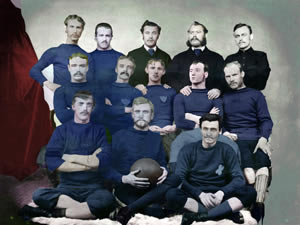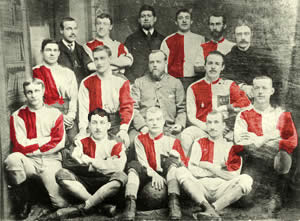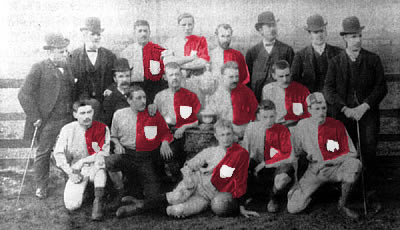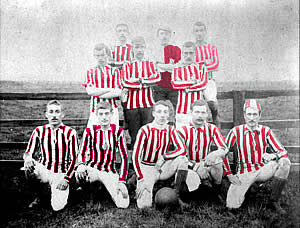The one thing that makes most teams instantly recognisable is their traditional strip. However the evolution to the famous red and white stripes that are worn by the Sunderland team is consistent with many clubs in that it wasnt the first outfit that they wore.
Here we chart the evolution of the Sunderland strip and the change to red and white stripes.
________________________
1879 to 1884
The original colours worn by Sunderland was an all blue strip, undoubtedly in due deference to Sunderland's first home ground at The Blue House Field, Hendon (could you really wear any other colour playing at a ground with such a name?).

As you can see from the above picture (the earliest of an SAFC team ever found) the team wore a blue top, blue shorts and either blue socks or, in the case of those who didnt fancy having their l;egs broke in those days (rough tackling was the norm), shin pads that have the distinct look of something akin to cricket pads about them. They certainly werent the light weight, hardly seen modern versions.
The badge that is visible on one or two of the tops isnt a Sunderland badge, it is that of Durham county that one or two of our players, such as James Allan, played a few representative games for.
1884 to 1886
On Saturday 13 December 1884 a good crowd, about 500, including a sprinkling of ladies saw Sunderland turn out against Castle Eden in new colours of red and white halved tops. The Echo decided that this was a great improvement on the blue strip but they wondered why Sunderland had chosen those colours which another un-named club in the county already wore. The new outfit brought us good luck as we defeated Castle Eden 8 v 1.

Why Sunderland all of a sudden moved to red and white is a moot point and for whcih there is no immediate answer. You will note that one of the players, our captain Jim McMillan is the only one with an "SFC" badge on his strip, signifying his leadership role within the club perhaps. A variety of shorts were worn, some dark and some light.
1886 to 1887
By 1886/87 the strip had evolved, not much, but this time the red part of the red and white halved top was now on the left hand side. ?The unfrotunate thing is that the picture below is of such poor quality that it is impossible to make out what the badge was, now sported by virtually all of our team.

If your eyesight is good you'll make out that again the shorts were not standard with some players wearing light and some dark.
1887/88
It had always been thought that as Sunderland wore the soon to be famous red and white stripes during the 1887/88 seaosn that they naturally wore them on the opening day of the season against Notts Mellors. However subsequent research has proved this to be incorrect. The strip was actually worn for the first time in the third game of the season against Darlington St Augustines on Saturday 24 September 1887.

The team had their picture taklen in their splendid new outfit before the game. It brought us good luck and a 1 v 0 victory. The Newcastle Daily Chronicle reported:
"Darlington St Augustines visited Sunderland for the 1st time this season on a fine day for a game which drew a crowd of fully 4,000 spectators to Newcastle Road. The home side wore their new uniform of red and white vertical stripes and white knickers for the 1st time and they looked very pretty when they took the field. The sides were well represented but O’Hare of Darlington failed to appear and Erskine of Sunderland guested for the visitors. The visitors won the toss and elected to play down the slope."
The game however wasnt so lucky for one unfortunate fan.
Towards the close of the game a sad incident occurred which cast gloom over proceedings. It seemed a 40 year old man named James Cowan of Cornhill in Southwick fell to the ground as if in a fit. He was rushed to the pavilion and was immediately attended to by Dr Pearcy who was on the ground but regrettably his services were of no avail as the man was dead having apparently suffered an epileptic fit. The deceased was a foreman at Messrs Laing & Co Shipbuilding Yard.
The picture shown above isnt of Sunderland playing that first game against Darlington. Looking at the lineup it is believed to be against Blackbiurn Rovers in a friendly on 12 November 1887. Sunderland lost 0 v 2. Therefore you are looking at the oldest known surviving picture of Sunderland AFC playing in red and white stripes. Note that the goalie still wears a red and white halved shirt.
_____________________________
Sunderland obviously had a change of heart as regards the strip for 1887/88. If you look on the Events Main Page of rokerpark.com you will see that the original fixture list for the season clearly shows us in the red and white halved top with the red on the left. Therefore we know that in the close season there was no obvious intention to change to the now familair red and white stripes.
South Bank Football Club point out that it was they who inspired the change to red and white when they lent us a set of strips when we were hard up. However there is no evidence to back up this assertion and therefore for now the reason for moving to red and white stripes remains a mystery. More research is required. For example there are no match reports currently researched that allude to SAFC playing in red and white stripes prior to the Darlington St Augustines game (see above).
From 1885 Newcastle United played in red and white stripes until changing to their now familiar colours in 1904. Middlesbrough Ironopolis played in red and white stripes in their only professional league season 1893/94. Wolves originally played in red and white stripes, as did Millwall and Oldham Athletic.
The last team to be English champions playing in red and white stripes was Sunderland AFC in 1935/36.
| 




